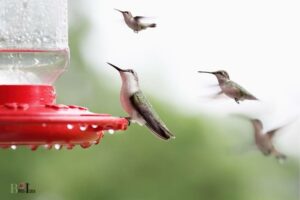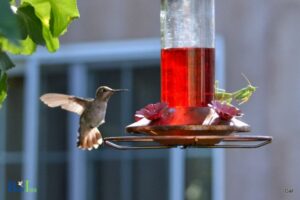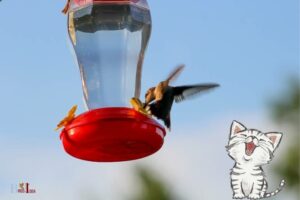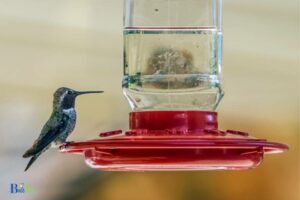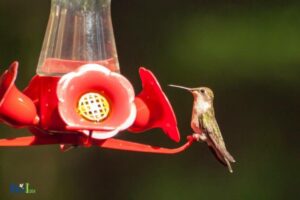DIY Bee Proof Hummingbird Feeder: Simple Techniques!
To create a DIY bee-proof hummingbird feeder, you can use a few simple techniques and materials to prevent bees from accessing the sugar water, while still allowing hummingbirds to feed easily.
As hummingbird feeders attract hummingbirds with a mixture of water and sugar, they can also unintentionally attract bees, wasps, and other insects.
By making a bee-proof hummingbird feeder, you can ensure that only hummingbirds can access the sugar water, keeping insects away and preventing any harm to the birds.
Using moats is an effective method to keep bees and wasps away from your hummingbird feeder, as they cannot cross the water-filled barrier.
You can create a moat by attaching a small cup or container filled with water above the feeder. Ensure that it is deep enough and frequently checked for evaporation.
6 Materials : About DIY Bee Proof Hummingbird Feeder
| Material | Description | Purpose |
| Hummingbird Feeder | A feeder specially designed for hummingbirds | To attract and feed hummingbirds |
| Bee Guards | Small plastic or mesh barriers | To prevent bees from accessing the nectar |
| Nectar Recipe | A homemade mix of sugar and water | To provide food for hummingbirds |
| Ant Moat | A water-filled moat that is hung above the feeder | To deter ants from reaching the nectar |
| Hanging Location | The place where the feeder is hung | To ensure the feeder is inaccessible to bees |
| Shaded Area | A location with less direct sunlight | To keep the nectar from fermenting and attracting bees |
Key Takeaway

Five Facts About: DIY Bee Proof Hummingbird Feeder
Materials And Tools Required
Creating a diy bee-proof hummingbird feeder requires specific materials and tools to ensure its effectiveness.
Here are the essential items that you will need:
Glass Feeder Jar With Lid And Feeding Ports
One of the most crucial components of any hummingbird feeder is the jar used to contain the nectar.
Here are some of the recommended features your jar should have:
- Glass jar with a capacity of at least 12 ounces
- A lid that can be securely fastened to the jar to prevent leaks
- Feeding ports that can be attached to the lid
Copper Wire Mesh Screen
Covering your hummingbird feeder with a copper wire mesh screen can help prevent bees from accessing the nectar.
Here are some important points to consider when selecting your mesh screen:
- Choose a copper wire mesh screen with small holes to prevent bees from reaching inside the feeder
- The mesh screen should be thick enough to withstand any attempts from bees to damage or pierce it
Scissors
Scissors are an essential tool to have when building your bee-proof hummingbird feeder.
Here’s why:
- You will need to cut the copper wire mesh screen to the appropriate size to cover the jar’s opening
- You may also need to trim any excess material that may be poking out after attaching the mesh screen to the jar’s lid
Pliers
Pliers can come in handy when building and attaching the components of your bee-proof hummingbird feeder.
Here are some of the reasons you’ll want to have pliers:
- You can use the pliers to bend and shape the copper wire mesh screen to fit snugly over the jar’s opening
- Use the pliers to adjust and tighten any of the components that may come loose over time
Glue Gun
A glue gun isn’t a mandatory tool for building your bee-proof hummingbird feeder, but it can be helpful.
Here’s why:
- You can use the glue gun to reinforce any of the components you attach to the feeder to ensure that they stay in place
- You may also use the glue gun to seal any portions of the jar where the components attach, preventing leaks
Feeder Hanger
Finally, you will need a way to hang your bee-proof hummingbird feeder outside.
Here’s what you should keep in mind:
- Look for a feeder hanger that is strong enough to hold the weight of the feeder when filled with nectar
- Choose a location to hang the feeder that is easily accessible for cleaning and refilling.
Steps To Make A Bee Proof Hummingbird Feeder
Creating an all-inclusive hummingbird feeder that solely caters to the bird is a task that every bird enthusiast is always trying to accomplish.
But, unfortunately, bees can rob the birds of their hard-earned food. Fear not, for we have an easy diy solution that cuts out those pesky bees.
Follow along to learn the steps to make a bee-proof hummingbird feeder.
Step 1: Remove The Lid And Feeding Ports Of The Glass Feeder Jar
Start by dismantling the hummingbird feeder, removing the jar’s lid and the feeding ports. Ensure that you place every part in an organized, easily recognizable spot for reassembly after the modifications.
Step 2: Measure The Copper Wire Mesh Screen As Per The Feeder Size
Using a measuring tape, measure the size of the jar and cut a copper wire mesh screen to the exact size of the jar to ensure its perfect fit.
Step 3: Cut The Copper Wire Mesh Screen
Once you have the measurements, cut the copper wire screen according to them. Using a pair of wire cutters, shape the screen as per the measurements.
Step 4: Attach The Copper Wire Mesh Screen To The Feeder
Using glue, attach the copper wire mesh screen to the jar’s underside. Ensure that it remains as seamless as possible.
The bees won’t be able to penetrate through the screen, but the little birds will be able to feed without any hindrance.
Step 5: Re-Attach The Lid And Feeding Ports
After the screen has been affixed, re-attach the lid and the feeding ports.
Step 6: Install The Feeder With Hanger
Install the feeder with a string or a hanger. Ensure that it’s secure and stable.
Step 7: Fill The Jar With Nectar
Fill the jar with nectar, and you are ready to go! The modifications are all done, and you have a bee-proof hummingbird feeder that will draw the birds to your garden in droves.
Making a bee-proof hummingbird feeder may seem like a daunting task, but these simple steps can go a long way in allowing birds to feed in peace while keeping pesky bees away. Enjoy the birds in your garden without worrying about their safety!
Tips For Using And Maintaining A Bee Proof Hummingbird Feeder
Hummingbirds are fascinating creatures that are a sight to behold as they flit around your garden. To keep these beautiful creatures coming back, you need to take care of your hummingbird feeder.
Maintaining a bee-proof feeder is essential as bees can quickly take over the feeder, thwarting the attempts of the hummingbirds to feed.
In this section, we will go over some tips for using and maintaining a bee-proof hummingbird feeder.
How To Control Ants And Other Insects
Ants and other insects can be a major problem when using a hummingbird feeder. These insects can chase the hummingbirds away and even infest your home.
Here are a few ways to control ants and other insects:
- Hang the feeder using fishing line, as ants cannot climb the slippery surface.
- Put an ant moat above or below the feeder. This process involves filling a cup with water and hanging it between the nest and feeder. The insects will get trapped in the cup and won’t be able to reach the feeder.
- Use insect guards or shields, which are special accessories that can prevent ants, bees, and other insects from getting inside the feeder.
How To Keep The Feeder Clean And Hygienic
It’s crucial to clean your hummingbird feeder regularly to keep it hygienic and free of mold and bacteria.
Follow these tips to keep your feeder clean:
- Clean the feeder every time you refill it.
- Replace the nectar every two to three days, especially during hot weather.
- Use a bottle brush or pipe cleaner to clean the bottle, base, and ports.
- Soak the parts of the feeder in hot water and white vinegar to clean any mold or bacteria.
When To Refill The Feeder
Hummingbirds need to be fed often, and you must keep the feeder filled with fresh nectar.
Here are some tips on when to refill the feeder:
- Refill the feeder every two to three days, especially during hot weather.
- You will know it’s time to refill the feeder when the nectar is empty, or it looks cloudy.
- Don’t overfill the feeder, as this can create a breeding ground for mold and bacteria.
How To Identify And Address Common Problems
Hummingbird feeders can have many problems that can cause them to stop working correctly, such as:
- Leaking: Make sure all parts are screwed tightly and that there are no cracks or damage.
- Bees or insects inside the feeder: Hang the feeder using fishing line, put an ant moat, or use an insect guard or shield.
- Empty nectar: Refill every two to three days.
By following these tips for maintaining a bee-proof hummingbird feeder, you can enjoy watching hummingbirds in your garden without the interruption of pesky bees and insects.
Remember to clean and refill your feeder often, and address any issues as soon as possible to keep your feeder functioning correctly.
FAQ On DIY Bee Proof Hummingbird Feeder
How Do I Prevent Bees From Getting Into My Hummingbird Feeder?
What Materials Do I Need To Make A Bee Proof Hummingbird Feeder?
How Effective Is A Diy Bee Proof Hummingbird Feeder?
Will A Bee Proof Hummingbird Feeder Also Keep Wasps Away?
Conclusion
After going through this blog post, it’s evident that making a diy bee-proof hummingbird feeder is a simple and effective solution. Attracting these delightful creatures while keeping bees out is indeed a wise approach to maintain a secure and healthy environment for all.
The step-by-step guide provided in this post has made it easy even for beginners to make one in a few simple steps, saving a lot of money.
By using materials that are readily available, it takes only a few minutes to get your diy bee-proof hummingbird feeder ready.
It’s essential to note that in addition to the safety measures, maintaining cleanliness of the feeder is crucial.
Consequently, it’s wise to clean it regularly to prevent it from becoming breeding grounds for bacteria or fungus that can harm the hummingbirds.
Overall, we believe diy bee-proof hummingbird feeders are the way to go if you wish to protect your hummingbirds from bees while still enjoying their vibrant beauty.

